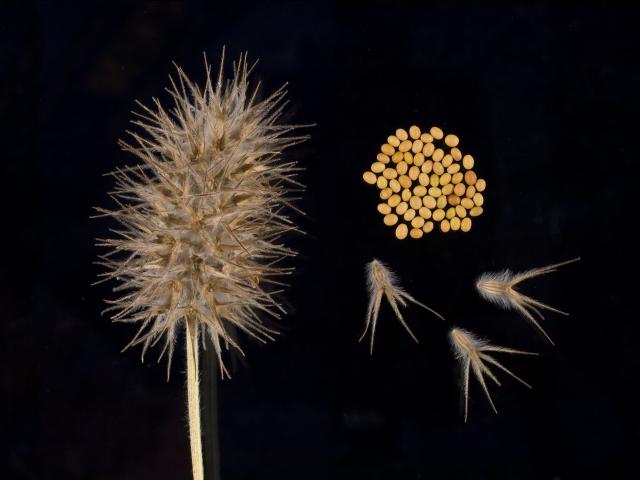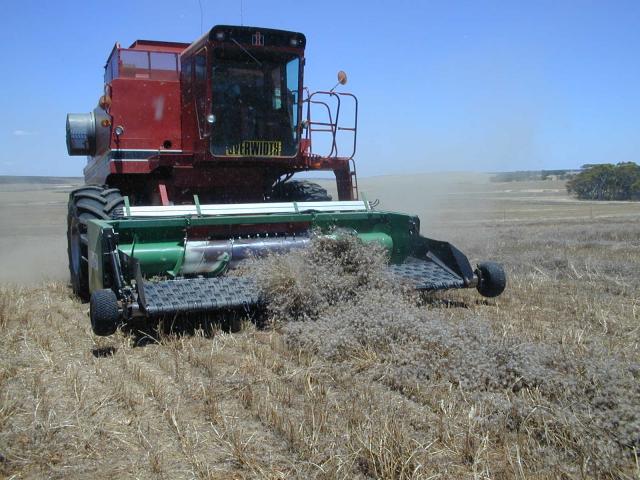Origin
Sothis eastern star clover was collected on the Greek island of Naxos in 1995. It has been developed by the Department of Primary Industries and Regional Development with the involvement of research officers Angelo Loi and Bradley Nutt and the pasture breeding team, as part of the National Annual Pasture Legume Improvement Program.
Description and area of use
Sothis is an early-mid maturing cultivar, flowering approximately 100 days from a mid-May sowing in Perth. Flowers are generally purple on the tip and whitish or pink at the base. Each seed is yellow in colour, slightly smaller than subterranean clover, with an approximate seed weight of 6mg. It is suited to Mediterranean climate regions with 325-450mm average annual rainfall and can be grown on mildly acidic to mildly alkaline sandy-loam and loamy soils (pH 5-8 CaCl2).
Forage production and seed yield
Field experimentation in Western Australia has shown herbage production in spring of ungrazed Sothis up to 5.6t/ha with seed yields from 300-650kg/ha. It has good forage quality, with dry matter digestibility of 65-70% and crude protein levels around 20% at the start of flowering. Agwest® Sothis grows rapidly in winter and can be moderately grazed during this time. Its upright habit makes it an ideal plant for mixtures with grasses that can be used later in the season for conserving silage or hay.
Hardseededness
Hardseeds of Sothis generally soften in late autumn. This provides considerable protection against seedling losses from false breaks, unlike the seeds of subterranean and balansa clovers, which generally soften in early summer. The levels of hard seed of Sothis remaining in the soil after the first autumn are about 65%, making it suited to self-regenerating ley systems or short-term phase farming systems (where it needs to be resown at the beginning of each pasture phase).
Using Agwest® Sothis as a tool for weed management
In regenerating pastures, the delayed germination of Sothis is a useful tool in controlling herbicide-resistant weeds. The long period of delayed germination allows the use of non-selective herbicides (and grazing where possible) at the break of the season for a period of up to six weeks.
Trials have found this technique can control more than 90% of the weeds present without compromising potential legume production. The table below shows the impact on clover and weed densities when this management system was used in a trial at Bakers Hill. The density of Sothis was only reduced by 35% following the herbicide treatment, compared to almost complete loss of subterranean clover, while weed densities, particularly the broadleaf (herb) component, were substantially reduced.
| Sown legumes | Grasses | Herbs | |
|---|---|---|---|
| Sothis - unsprayed | 722 | 6325 | 3548 |
| Sothis - sprayed | 475 | 165 | 0 |
| Dalkeith - unsprayed | 5160 | 5295 | 3682 |
| Dalkeith - sprayed | 161 | 145 | 4 |
Sowing
As with other pasture legumes, Sothis should be treated as a crop in its first season to ensure maximum seed set. Minimise competition from weeds by spray-topping the paddock in the previous spring or select a paddock that was cropped to cereals or canola in which broad-leaf weeds were successfully controlled. In very weedy situations the sowing can be delayed for 2-3 weeks for better knockdown weed control with little impact on subsequent growth. Sothis requires rhizobial inoculation with Group C (clovers).
It should be sown at 10-15kg/ha when planted alone, but lower rates can be used when sown in a pasture mixture. Sowing depth of Sothis should be no more than 2cm. When establishing Sothis, ensure adequate nutrition, particularly phosphate and potassium. Monitor for insect pests and apply an appropriate insecticide if necessary. Graze lightly in the first season, particularly in spring, to allow maximum seed set.
Disease and pest tolerance
Sothis is very susceptible to clover scorch (Kabatiella caulivora) and should not be grown where this disease commonly occurs. However, the main target environment for this cultivar is the low to medium rainfall wheatbelt where clover scorch is unlikely.
Sothis is also very susceptible to chocolate spot (Botrytis fabae) and grey mould (Botrytis cinerea) and it should not be grown before or after grain legume crops. Second year pastures will be at greatest risk.
Field observations have indicated similar sensitivity to redlegged earth mite at the seedling stage as subterranean clover. The cultivar is sensitive to both cowpea and blue green aphids. Lucerne flea has been observed to be less damaging in spring on Sothis than in subterranean clover. Normal control precautions for pasture legumes should be taken for each of these pests.
Herbicides
Herbicide trials at Northam indicate that Sothis is sensitive to many of the more common broadleaf herbicides, including Bromoxynil, Tigrex®, Spinnaker®, Raptor® and Broadstrike®. There are currently no broadleaf herbicides registered for use on eastern star clover. Grass weeds can be safely controlled with grass selective herbicides.
Seed harvesting
Seed of Sothis can be harvested with modified grain harvesters. The seed sheds from the plants and the timing of harvest is critical. Best results are obtained when the crop is swathed, ensuring even drying and minimal seed shedding. Botrytis can be carried in the seed so diseased crops should not be harvested.
Production and marketing
Sothis is a public variety and can be freely bought and sold.


